Today is Mother’s Day (I do hope you didn’t
forget), also known in the past as Mothering Sunday. It is the middle Sunday in
Lent, called Dominica Refectionis, the Sunday of Refreshment, by legend
the day on which Christ fed the five thousand, when parishioners would visit
their cathedral, or ‘Mother church’, taking gifts of denarii quadrageminales,
or Lenten pennies. The practice died out in the mid-thirteenth century but the
common custom continued as servants and apprentices were given time away from
their duties in order to visit their natural mothers. They would either receive
or give gifts of fine bread or cake, an especial treat for those who usually
ate coarser fare, which had the name simnel, coming from the Latin simila
– fine flour, through the Old French simenel (semolina
derives from the same root, as does the German word for a roll – semmel).
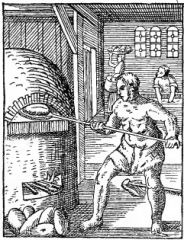 |
| A Bakery |
In the past, there were four types of bread, the very best of which was made
with the finest flour and this was simnel. Next down the scale and the finest bread
eaten ordinarily was called wastel, followed by cocket, and
finally, of poorest quality, was bread of treet; simnel and wastel would
be made with wheat flour, the ordinary bread was made with barley, with the
peasants bread made from rye, oats and beans. The English simnel was the purest
white bread, as in the Book of Battle Abbey,
“Panem regire mensre apsum, qui simenel vulgo vocatur.”(Bread fit for the royal table, which is commonly called simenel.)
Legislation on the quality and weight of loaves
came early to English law and there are numerous records of bakers being
punished for selling ‘light’, or underweight, bread – this example is from
Robert Fabyan’s Chronicle of 1268,
“In processe of tyme after, the sayde syr Hughe, with others, came to Guylde hall, & kepte his courte and plees there withoute all ordre of lawe, and contrary to the lybertyes of the cytie, and there punysshed the bakers for lacke of syze by the tuberell, where before tymes they were punysshed by the pyllery, and orderynge many thynges at his wyll, more than by any good ordre of lawe.”
Specific weights were
designated to each loaf, according to cost, from eighteen penny loaves down to
two penny loaves, and just to be on the safe side, when it came down to penny
loaves, bakers would throw in an extra loaf for every twelve loaves bought,
which is why we call thirteen of anything ‘a baker’s dozen’ (when it
came to half-penny loaves, two extras would be given – Grose, in his Dictionary
of the Vulgar Tongue, defines Baker’s Dozen as
“BAKER'S DOZEN, fourteen-, that number of rolls being allowed to purchasers of a dozen.”
 |
| Another Bakery |
Robert Herrick, in A Ceremonie at Glocester wrote,
“Ile to thee a Simnell bring,'Gainst thou go'st a mothering,So that, when she blesseth thee,Half that blessing thou'lt give me.”
Over the years, the simnel bread
became more elaborate as further ingredients were added and it metamorphosed
into a simnel cake, which is delicacy still enjoyed particularly in the North
of England.
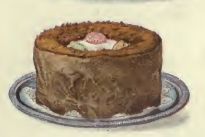 |
| Simnel Cake - from Mrs Beeton Book of Household Management - 1907 ed. |
One apocryphal story says that an old couple, Simon and Nell, set
to make a treat for their children, Nell making an unleaven crust which Sim
filled with the remains of the Christmas pudding. He said that the result
should be boiled, as it was a pudding, but Nell said it needed to be baked, as
it was a pie, so they compromised and cooked it both ways, and as it was so
delicious it was named for its creators, Sim and Nell.
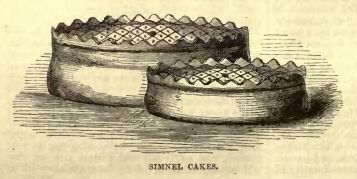 |
| Simnel Cakes |
There were regional
variations - at Shrewsbury, it took the form of a Warden pie (i.e. made from
Warden pears), with a very thick crust flavoured with saffron, at Devices, the
pie was star-shaped, made with saffron, currants, spices, candied peels and
made without the crust, whilst at Bury, the cake was made with dried fruits and
nuts and was more like a biscuit than a cake. Today, Simnel Cake is a two-layer
fruitcake with marzipan in the centre and on the top, decorated with a candle
(to represent Christ) and eleven marzipan balls (representing the apostles
minus Judas).
Simnel Cake was accompanied in Lancashire with Bragget Ale, a name
that comes from the Celtic bracata and the Welsh bragawd, old
names for mead, and has links to the old Scots Bragwort, another drink made
from honey; Bragget Ale in later days was a spicy, mulled beer, famously made
around Leigh, and this practice has echoes of Shakespeare’s phrase ‘cakes
and ale.’
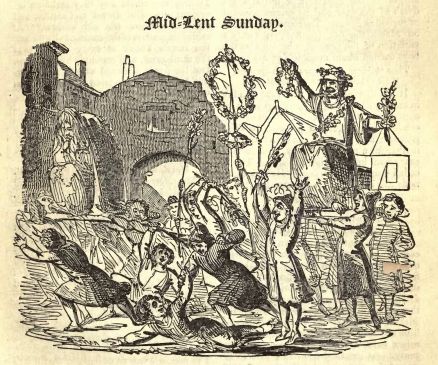 |
| Mid-Lent Sunday |
In some places, there were other variations – figs were eaten as
a memory of Jesus coming down into Jerusalem from Bethany, when he had a taste
to eat figs, and fig cakes were baked, which in Lancashire were called
Fag-Pies, made from figs, spices and treacle on mid-lent Sunday in Blackburn
and Clitheroe, and on the following Sunday in Burnley. A local rhyme says,
“Methodies swears, Dippers [i.e.Baptists] lies,And Church-folk eats all th’ fag-pies.”
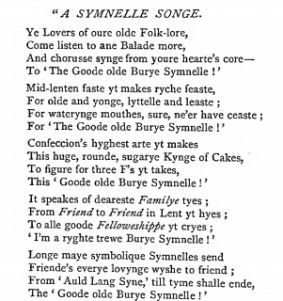 |
| A Symnelle Songe |
Yet another name for Mothering Sunday, its name coming from
another food, is Furmety Sunday, furmety or frumenty being whole grains
of cracked wheat that are boiled in water, then added to milk, spices, raisins,
sugar and boiled again and sometimes almonds, eggs or saffron are also added
(together with a healthy slug of spirits – brandy, rum or whisky); Frumenty
comes from the Latin frumentum – ‘grain’. Frumenty was often served with
meat, particularly venison, and was also a Christmas Day favourite.
No comments:
Post a Comment